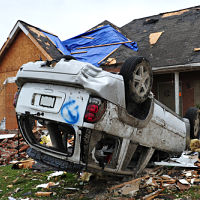
 |
|

|
Chemical Spill Response PURPOSE: It is the purpose of this policy to establish a standard for response to emergency hazardous material spills within the Facility complex. POLICY: It is the intention of Inter-Lakes health to utilize trained personnel and appropriate materials for safe clean up of hazardous material spills and/or releases. TRAINING PROCEDURE: 1.Training and Documentation of Training; Department managers and Supervisors will be responsible for training and documentation of training for their staff members on department policy and procedures. a.All new staff will receive training before being assigned to handle or dispose of any hazardous material or waste. b.Department Director or Supervisors are responsible for completing and returning the attached in-service sheet to the Director of Environmental Services within 10 days. RESPONSE SPILL KITS: Any department identified as having a potential hazardous spill will maintain required spill kits for containment purposes. The Department with the highest level of proficiency with regards to a spill shall be responsible for initial clean up. 1. CHEMICAL SPILL KIT: Responsible Person/Department for initial cleanup: Dave Schryer Hazmat Team/Dave Morin Facilities Final Clean up: Environmental Service Broom Plastic Dust Pan Absorbent Material Disposal Container Nitrile Gloves Nitrile Apron Vinyl Boots Splash-proof Goggles Dust Mask Full Face Shield Hazardous Waste Labels 2. FUEL OIL SPILL KIT: Responsible Person/Department for cleanup: Dave Morin/Charlie Moore Facilities and Safety Location: Boiler Rooms (Hospital and Nursing Home) 10 Bags of Speedy Dry 1 Box of Absorbent Socks 2 Flat Shovels 2 Brooms 2 pair Rubber Boots PROCEDURE FOR CLEANING UP SPILLS: A. Minor Spills: Note: A minor spill is characterized by the confidence and the capability of unit personnel to clean up a spill without the assistance of emergency personnel even though the cleanup procedure may require specialized knowledge and specialized equipment. A relatively small area is affected and only a relatively small number of employees may need to leave the area until the spill is cleaned up.  Put absorbent from the spill kit on the material, if the material spilled is a liquid form (and if this can be done safely); Close area off to keep people from entering. Put absorbent from the spill kit on the material, if the material spilled is a liquid form (and if this can be done safely); Close area off to keep people from entering. Call in personnel from the Department specified as proficient in handling this type of spill and the Safety Officer; Call in personnel from the Department specified as proficient in handling this type of spill and the Safety Officer; Take appropriate action to remove the hazard; Take appropriate action to remove the hazard;Clean up the area;  Additional information or assistance on a minor spill cleanup may be obtained from the Safety Officer; Additional information or assistance on a minor spill cleanup may be obtained from the Safety Officer; Do not use respiratory protective equipment unless you are trained in its safe use. Do not use respiratory protective equipment unless you are trained in its safe use.B. Major Spills Note: A major spill has occurred under one or more of the following conditions: 1.A life threatening condition exists; 2.The condition requires the assistance of emergency personnel; 3.The condition requires the immediate evacuation of all employees from the area or building; 4.The contents of the spilled material are unknown; 5.The spilled material is highly toxic, bio-hazardous, radioactive, or flammable; 6.Employee feels physical symptoms of exposure. In the event of a major spill (individual judgment required) the person in charge at the scene shall notify:  Administrator on-call or PCC Administrator on-call or PCC  Department Manager of associated area Department Manager of associated area Director of Facilities/Environmental Services Director of Facilities/Environmental ServicesThe Administrator on-call, PCC, Department Manager of associated area, Director of Facilities, or Environmental Services are responsible to notify an outside Hazardous Materials Team or Fire Department if the hazardous spill is deemed too large to be handled internally. GENERAL RESPONSE PROCEDURE: 1.Evacuate area and close all doors. 2.Establish communication with manufacturer of designated chemical. 3.Inform Security, immediate Supervisor, PCC, and the Director of Facilities. 4.Put on personal protective equipment. 5.Restrict the area with barrier tape. Contain the chemical. 6.Establish a safe environment, by providing appropriate ventilation (coordinate with Facilities). 7.Clean up; test, follow-up test, all clean and dispose of chemicals properly. 8.Document the incident and report to the Risk Manager. 9.Critique event. PERSONAL PROTECTIVE EQUIPMENT: Personal protective equipment (i.e., gloves, gown, mask, respiratory devices, etc.) shall be worn as needed when working to prevent injury. EMERGENCY TELEPHONE NUMBERS: If further information regarding a spill incident is required, call the national hotline for chemical spills. The combination of two or more chemicals may precipitate an unusual reaction, and require a different clean-up procedure. COMPANY Essex County Emergency Services CONTACT NUMBER 9-873-6321 COMPANY Ticonderoga Fire Department CONTACT NUMBER 9-911 COMPANY Environmental Product Services CONTACT NUMBER 1-800-977-4559 COMPANY New York State D.E.C. CONTACT NUMBER 1-800-457-7362 DISTRIBUTION: This policy will be distributed to the Administrative Staff, Department Managers, and Nurse Managers. All recipients of this policy must acknowledge their receipt and understanding of this policy by referring any questions or problems with the policy within ten days of the issue date to their immediate supervisor. If no questions or problems are stated, it will be assumed that the policy has been read and understood. All questions regarding this policy or its implementation may be referred to the Director of Environmental Services. |
|
|||||||||||||||||||
| Inter-Lakes Health, 1019 Wicker Street, Ticonderoga, NY 12883, (518) 585-2831 | |||||||||||||||||||||
| ©2025 FastHealth Corporation Terms Privacy | US Patent Numbers 7,720,998 B2, 7,836,207 |